At the beginning of the Victorian gold rushes in 1851, most of the people searching for the valuable yellow metal were male and dressed suitably for the tough camping and working conditions experienced on the goldfields. As it was dusty in summer and muddy in winter, a miner needed long leather boots to protect him from the mud, a broad-brimmed hat (usually made of felt) to keep the sun or rain out of his eyes, a comfortable cotton shirt, and a waistcoat. Here is a description of winter on the Ballarat goldfields:
This was called Gravel Pit Lead, but might with more propriety have been called Mud Hole; for a more astonishing scene of mud, muddy water, muddy diggers, muddy tools, and clay trodden into the most vilely adhesive filth, it is impossible to conceive. In fact, Ballarat in winter is unquestionably the most dirty place, the most perfect Serbonian Bog, on earth …- William Howitt Land, Labour and Gold; or Two Years in Victoria, Longmans, London, 1855, p.380
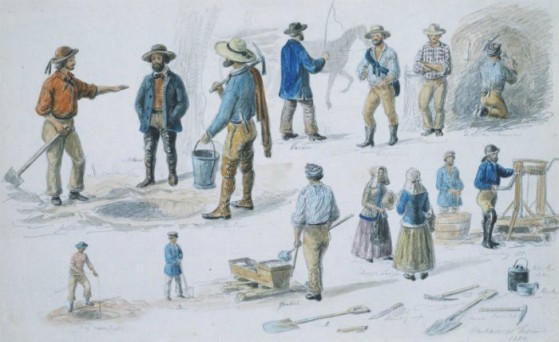
Typical Ballarat clothing in the early 1850s – note the long leather boots. Eugène von Guérard, Blackhill 21 Febrav [February] 1854, Reproduced with permission from the State Library of Victoria.

Gold Museum Curator, Snjez Cosic, modelling a fine example of 1850s fashion made recently by the Sovereign Hill Costume Department. Reproduced with permission from Jade Smithard, Mojo Photography.
It didn’t take long, however, for the wealth from gold to start attracting women and families to the diggings. As living conditions improved and permanent houses were built by the mid-1850s, the trendiest fashions from England, France and the USA began to grace the (still rather muddy) streets. It was no wonder – Ballarat had become one of the richest places in the world by this time, and the fashions sported by residents reflected this new wealth.
While crinolines and corsets, top hats and bling were all the rage, these flashy fashions, much like many today, were about communicating your social class (or status) in society – meaning they showed others how important you were. While the poor (and there were plenty of people at this time who weren’t reaping the rewards of the gold rushes) wore whatever clothing they could patch together, the rich were enjoying fancy fabrics, new dye colours thanks to the Industrial Revolution, and expensive accessories. Fashion brand names weren’t really invented yet, so instead of showing off your money by displaying an expensive brand across your chest like many people do today, you paraded around in lace, silk ribbons, tall hats and elaborate gold jewellery to show off. It will be no surprise that large pieces of gold jewellery were all the rage in Ballarat in the 1850s.
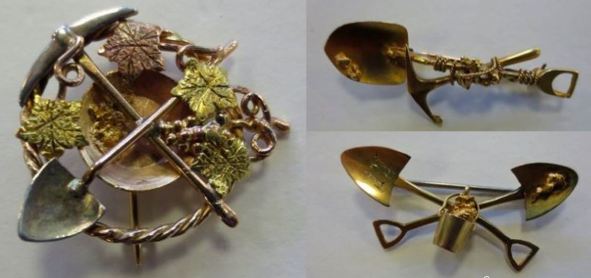
Brooches made of Ballarat gold. Reproduced with permission from the Gold Museum.
At this time in history, cotton fabric was quite cheap to buy for sewing into dresses and shirts, because the plants that produce it were mostly being planted and harvested by African slaves in the USA. As cotton plantation (farm) owners didn’t pay their workers, this very cheap material was transported all over the world and was affordable to everyone; it was turning it from cloth to clothing that cost a lot of money (paid to a tailor/seamstress) or time (for the hardworking housewife). Poorer women made their own clothes by hand (until the sewing machine became widely accessible in Australia in the early 1860s), while wealthy women had their clothes tailor-made.
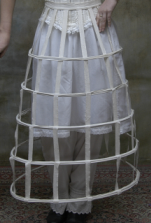
An example of a crinoline created by the Sovereign Hill Costume Department. Underneath you can see the model’s pantalettes (undies!) and chemise (like a long singlet).
It might surprise you to learn that few people owned wardrobes until recent times, as even the cheapest clothing was still very expensive by today’s standards, which meant that during the gold rush each person only owned a couple of outfits. Clothes are so cheap today in comparison that Australians buy 27kg of new clothes on average per year, making us the second largest consumer of textiles in the world!
Interestingly, the bell-shaped crinoline underskirt which is probably the most well-known fashion of the mid-1800s was viewed by many women of the time as a liberating garment because they could walk more easily than beforehand when they had worn many layers of skirts to make the same shape. While some cartoonists saw the funny side of crinolines which many called ‘crinoline mania’, wearing one could be dangerous as they caught fire easily. Corsets were dangerous, too, when worn very tight – most women wore them like bras are worn today, while the rich and fashion-conscious sometimes wore them so tight they broke ribs and moved vital organs. The Victorian dress reform movement saw women encouraging other women to give up dangerous and uncomfortable clothing from the 1850s onwards, and this was thought by many to represent the first wave of feminism.
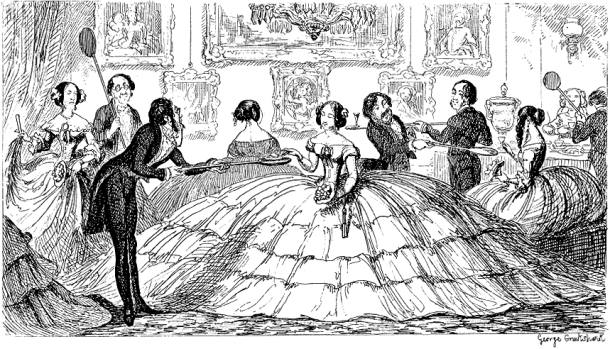
‘A Splendid Spread’, a cartoon about crinolines by George Cruikshank, from The Comic Almanack, 1850. Reproduced with permission from Wikipedia Commons.
For men who had already found their fortunes on the goldfields, the wearing of white shirts, tall top hats and swinging about a fancy cane showed off their status, along with sporting beautiful fob or pocket watches. If your great-grandfather handed down his watch through your family, it is likely it was his most valuable and treasured possession, although by the late 1800s they became much cheaper thanks to the Industrial Revolution.
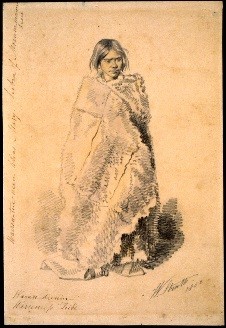
This is a goldrush sketch of a Wadawurrung girl from Ballarat wearing a warm possum-skin cloak – the pelts of brushtail possums are warmer than wool and are waterproof. William Strutt, Waran-drenin, 1852. Reproduced with permission from the British Museum.
Australian-specific clothing became available from the 1850s onwards due to the special furs of our native animals. Warm brushtail possum pelts (the fur with the skin [leather] still attached) sewn together and turned into rugs which were supplied by local Aboriginal people, were useful for keeping miners alive during a Ballarat winter in a tent. As platypus pelts were fashioned into expensive jackets and rugs for the wealthy, it’s no wonder that platypus are so rarely seen in the wild these days.
The Sovereign Hill Museums Association has many pieces of clothing and jewellery in our collection of artefacts from the 1800s; however, they are mostly the fanciest items that people treasured, rather than everyday items. That’s why Eliza Perrin’s dress is a particularly special piece in our collection – watch a video about it in Chapter 6 of our ABC Education ‘digibook’ here. You can also learn about the popularisation of white wedding dresses here, fashionable 1850s hair dos here, how the Sovereign Hill Costume Department researches and makes our 1850s clothing here, the differences between clothing now and 19th century clothing here, and typical children’s clothing from the goldfields era here.
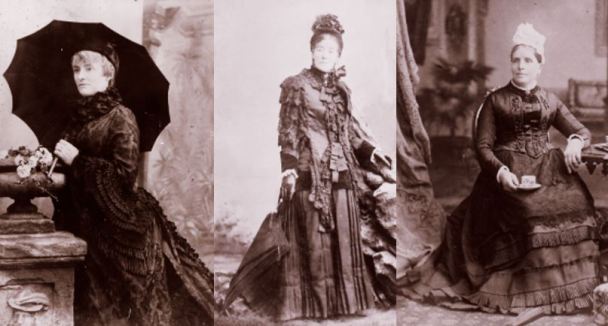
Ruffles, ribbons, fringes and extra details on outfits showed off one’s wealth in the late 1850s. Reproduced with permission from the Gold Museum (these Ballarat women are unidentified).
Links and References
A brief history of the ‘rush’ to Ballarat: http://education.sovereignhill.com.au/media/uploads/SovHill-lifeonthegoldfields-notes-ss1.pdf
Wikipedia on crinolines: https://en.wikipedia.org/wiki/Crinoline
A Gold Museum blogpost about another interesting dress in our collection: http://www.goldmuseum.com.au/a-victorian-dress/
Wikipedia on corsets: https://en.wikipedia.org/wiki/Corset
The history of men’s white shirts: https://theconversation.com/the-story-of-the-mens-white-shirt-26312
BTN on the amount of modern clothing Australians waste: http://www.abc.net.au/btn/story/s4663466.htm
A platypus fur cape in the National Gallery of Victoria collection: https://www.ngv.vic.gov.au/fashion-detective/









Enjoyed our trip to Sovereign Hill. We felt as though we were back in time wandering the “downtown” streets and perusing Victorian stores. Hailing from Detroit Michigan , it reminded us of the Henry Ford . Great experience. Great museum as well.